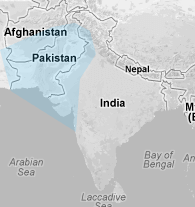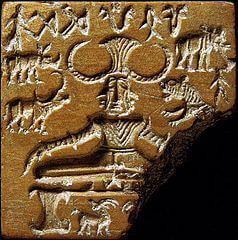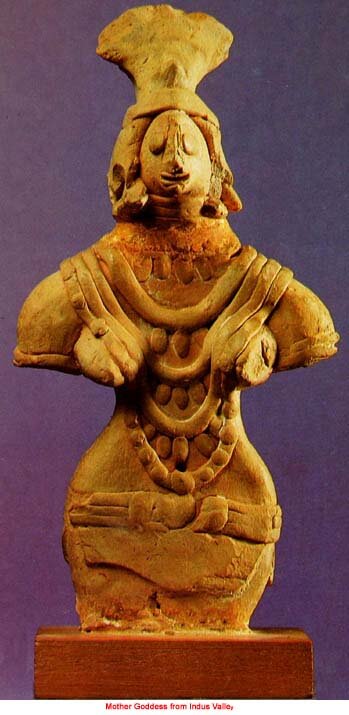Early civilisation and the first Gods
The bronze age of man bought with it a more organised religion than which was practiced in the stone age. The great civilisations of the period, — Ancient Egyptian in Africa, Mesopotamia in Central Asia and the Indus Valley Civilisation in north India — developed the first thought forms of the Godhead, the beginnings of religion. Their beliefs evolved slowly over the centuries and gradually developed into a comprehensive world view shared by the people.
It is widely accepted that civilisation in India began and evolved in the valley of the Indus (Sindhu) river in the period 3300-2600 BCE. These settlements evolved into the Mature Harappan civilisation in the period 2600-1900 BCE. It was located in the northwestern region1 of the Indian subcontinent, consisting of what is now mainly present-day Pakistan and northwest India.Flourishing around the Indus River basin, the civilization extended east into the the upper reaches of the Ganga & Yamuna plains; it extended west to the coast of Balochistan, north to northeastern Afghanistan and south to Daimabad in Maharashtra. The civilization was spread over some 1,260,000 km, making it the largest ancient civilisation of the bronze age period.

The Harappan civilisation was one of the most advanced civilisation amongst its contemporaries. Mostly urbanised, the principle cities of Harappa, Mohenjo-Daro, Dholavira, Kalibangan and Lothal acted as trade centres for local merchants as well as traders from Mesopotamia and Egypt.
The ancient systems of drainage and roadways that were developed and used in the cities of Harappa were advanced, and more efficient that systems currently employed in India and Pakistan.
Despite this heavy urbanisation, the Harappan civilisation seems to have had a high regard for nature and the environment. This can be derived from the high usage of animals and animal forms in the seals, and pottery excavated from the period. This same regard for nature extended into the religious behaviours of the Harappan people.

Pashupatinath - Lord of the Animals

The Pashupatinath device was seen on multiple seals from the period. This seal shows a horned figure seated in a familiar yogic pose with both feet touching each other. This figure is surrounded by different animals including a rhinoceros, buffalo, tiger, and an elephant. This Proto-Shiva can be identified as a deity who is the lord / leader of animals. A precursor to the later Hindu gods — Rudra or Shiva.
** The Mother Goddess** The people of the Indus Valley cities, also worshiped a Mother Goddess. The importance accorded to these roles and also to the feminine, can be drawn from the number of figurines excavated. The important uncovered poses include a Dancing Girl, and terracotta figurines of what can be identified as Fertility goddess.

One of the largest female figurines found at Harappa has a (badly broken) fan-shaped pannier headdress with black residue in the cups of the panniers and a forward-projecting face. She is heavily ornamented with an elaborate choker and two other necklaces, each with three strands and many pendants. This elaborate ornamentation of figurines is one reason that female figurines have often been interpreted as deities, most commonly as “Mother Goddesses.”
Residues that may indicate burning of oils or other substances in the panniers have also prompted a cultic interpretation and ritual worship.
** Ritual and Ceremony**
The recovered seals from the Harappan civilisation provide a possible insight into the ritual and ceremony surrounding daily life in the centres. This particular seal (below) depicts a deity with a horned headdress and bangles (maybe female) on both arms, standing in a pipal tree and looking down on a kneeling worshiper. A giant ram watches.


Several script signs are interspersed with the figures along the top of the seal and a single sign is placed at the base of the tree. This scene may represent a special worship ritual to a deity with seven figures in procession.
The Indus Valley civilisation thus provides us with the seeds for some of the Gods and Goddesses which form a path of the Hindu pantheon.
A key aspect to note is that most early interpretations of the pantheons across multiple civilisations and religions meet a core need of human life – fertility and the progenitors. This representation of the male and female can be seen across bronze age civilisations in Egypt, Mesopotamia, India and even in later bronze age civilisations like Japan and Korea.
This representation of fertility repeats itself again in future renditions of god and religion as we will see.
Further Reading & References
^1 ^2 ^3 ^4 [^5][6] Indian Archaeology, A Review.- 1958-1959. Excavations at Alamgirpur. Delhi: Archaeol. Surv. India, pp. 51–52 Leshnik, Lawrence S. (October 1968). “The Harappan “Port” at Lothal: Another View”. <em>American Anthropologist, New Series,</em> <strong>70</strong>(5): 911–922. [https://www.harappa.com/indus/33.html][7] [https://www.harappa.com/indus/34.html][8] [https://www.harappa.com/figurines/15.html][9] Indus Civilization: Clues To an Ancient Puzzle, National Geographic Magazine – June 2000
[6]: https://uk.encarta.msn.com/encyclopedia_761556839/indus_valley_civilization.html “Encarta” (Dead Link) [7]: https://www.harappa.com/indus/33.html [8]: https://www.harappa.com/indus/34.html [9]: https://www.harappa.com/figurines/15.html